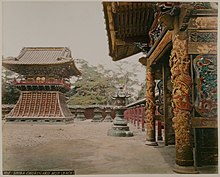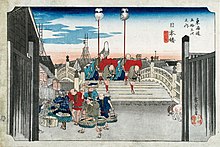Edo: Difference between revisions
m WP:GEO: adding {{coord missing|Japan}} |
→Gallery: new version of EDO PANORAMA |
||
| Line 144: | Line 144: | ||
==Gallery== |
==Gallery== |
||
{{wide image|Panorama |
{{wide image|Edo Panorama old Tokyo color photochrom.jpg|1666px|Edo, 1865 or 1866. [[Photochrom]] print. Five albumen prints joined to form a panorama. Photographer: [[Felice Beato]]}} |
||
== See also == |
== See also == |
||
Revision as of 17:16, 22 May 2009
Edo
江戸 Yedo | |
|---|---|
Former city | |
 Former location of Edo and Present location of Tokyo | |
| Country | Japan |
| Castle Built | 1457 |
| Capital | 1603 |
| Renamed Tokyo | 1868 |
| Population (1721)[1] | |
| • Total | 1,000,000 |




Edo (江戸), literally: bay-door, "estuary", IPA: [edo]), also romanized as Yedo or Yeddo, is the former name of the Japanese capital Tokyo, and was the seat of power for the Tokugawa shogunate which ruled Japan from 1603 to 1868. During this period it grew to become one of the largest cities in the world and the site of a vibrant urban culture centered on notions of the "floating world".[1]
History
Edo magistrates
- Ishimaru Sadatsuga, 1661.[2]
From the establishment of the Tokugawa bakufu''s headquarters at Edo, Kyoto remained merely the formal capital of the country. The de facto capital was now Edo, because it was the center of real political power. Edo consequently rapidly grew from what had been a small, virtually unknown fishing village in 1457 to a metropolis of 1,000,000 residents by 1721, the largest city in the world at the time.[1][3]
Edo was repeatedly devastated by fires, with the Great Fire of Meireki in 1657—in which an estimated 100,000 people died—perhaps the most disastrous. During the Edo period there were about one hundred fires, typically started by accident and often quickly escalating to giant proportions, spreading through neighbourhoods of wooden machiya that were heated with charcoal fires. Between 1600 and 1945, Edo/Tokyo was leveled every 25–50 years or so by fire, earthquakes, tsunami, volcanic eruptions, and war.
In 1868, when the shogunate came to an end, the city was renamed Tokyo, meaning "eastern capital", and the emperor moved his residence to Tokyo, making the city the formal capital of Japan.
- Keiō 4, on the 17th day of the 7th month (September 3, 1868): Edo was renamed "Tokyo," i.e. meaning "Eastern Capital."[4]
- Keiō 4, on the 27th day of the 8th month, (October 12, 1868): Emperor Meiji is crowned in the Shishin-den in Kyoto.[5]
- Keiō 4, on the 8th day of the 9th month (October 23, 1868): The nengō is formally changed from Keiō to Meiji; and a general amnesty is granted.[5]
- Meiji 2, on the 23rd day of the 10th month (1868): The emperor went to Tokyo; and Edo castle became an Imperial palace.[5]
Government and administration
During the Edo period, the Shogunate appointed administrators called machi bugyō to run the police and, from the time of Tokugawa Yoshimune onward, the commoner fire department (machibikeshi). The machi bugyō heard criminal and civil suits and performed other administrative functions.
Geography
The city was arranged as a castle town, around Edo castle. The area immediately surrounding the castle, known as the "Yamanote", consisted largely of daimyō (feudal lords') mansions, whose families lived in Edo year-round as part of the sankin kōtai system; the daimyō themselves made journeys in alternating years to Edo and made use of these mansions for their extensive entourages. It was this extensive samurai (noble warrior class) population which defined the character of Edo, particularly in contrast to the two major cities of Kyoto and Osaka, neither of which were ruled by a daimyō or had any significant samurai population. Kyoto's character was dominated by the Imperial Court, the court nobles, its numerous Buddhist temples, and its traditional heritage and identity, while Osaka was the country's commercial center, dominated by the chōnin merchant class.
Other areas further from the center were the domains of commoners, or chōnin (町人), literally "townsfolk." The area known as Shitamachi (下町, lit. "lower town" or "downtown"), to the northeast of the castle, was perhaps one of the key centers of urban culture. The ancient Buddhist temple of Sensō-ji still stands in Asakusa and marks the center of an area of traditional "low-town" culture. Some of the shops in the streets before the temple have been carried on continuously in the same location since the Edo period.
The Sumida River, then simply called the Great River (大川), ran along the eastern edge of the city, along which one would find the shogunate's official rice storage warehouses[6] and other official buildings, along with some of the city's most famous restaurants.
The Edo Bridge (江戸橋, Edo-bashi) marked the center of the city's commercial center, an area also known as Kuramae (蔵前, "in front of the storehouses"). Many fishermen, craftsmen, and other producers and retailers operated here, as did shippers who managed ships to and from Osaka (called tarubune) and other cities, either taking goods into the city, or simply transferring them from sea-routes onto river barges or onto land routes such as the Tōkaidō, which terminated here. The area remains the center of Tokyo's financial and business district today.
The northeastern corner of the city, regarded as a dangerous direction in traditional onmyōdō (cosmology/geomancy), is guarded from evil spirits by a series of temples, including Sensō-ji and Kan'ei-ji. Just beyond these lay the districts of the eta or outcastes, who engaged in unclean vocations and were thus separated from the main sections of commoner residences. A long dirt path extended west from the riverbank, a short distance north of these eta districts, leading along the northern edge of the city to the Yoshiwara pleasure districts. Previously located within the city proper, close to Asakusa, the districts were rebuilt in this more distant location after the Meireki Fire of 1657.
Gallery
See also
- 1703 Genroku earthquake
- Edokko (native of Edo)
- History of Tokyo
- Iki (a Japanese aesthetic ideal)
Notes
- ^ a b c Sansom, George. A History of Japan: 1615–1867, p. 114.
- ^ Encyclopedia Britannica (1911): "Japan: Commerce in Tokugawa Times," p. 201.
- ^ Gordon, Andrew. (2003). A Modern History of Japan from Tokugawa Times to the Present, p. 23.
- ^ Ponsonby-Fane, Richard. (1956). Kyoto: the Old Capital, 794–1869, p. 327.
- ^ a b c Ponsonby-Fane, p. 328. Cite error: The named reference "p328" was defined multiple times with different content (see the help page).
- ^ Taxes, and samurai stipends, were paid not in coin, but in rice. See koku.
References
- Gordon, Andrew. (2003). A Modern History of Japan from Tokugawa Times to the Present. Oxford: Oxford University Press. ISBN 0-195-11060-9/ISBN 978-0-195-11060-9 (cloth); ISBN 0-195-11061-7/ISBN 978-0-195-11061-6.
- Ponsonby-Fane, Richard. (1956). Kyoto: the Old Capital, 794–1869. Kyoto: Ponsonby Memorial Society.
- Sansom, George. (1963). A History of Japan: 1615–1867. Stanford: Stanford University Press. ISBN 0-8047-0527-5/ISBN 978-0-804-70527-1.
- Akira Naito (Author), Kazuo Hozumi. Edo, the City that Became Tokyo: An Illustrated History. Kodansha International, Tokyo (2003). ISBN 4770027575
- Alternate spelling from 1911 Encyclopædia Britannica article.
External links
![]() Media related to Edo, Japan at Wikimedia Commons
Media related to Edo, Japan at Wikimedia Commons

